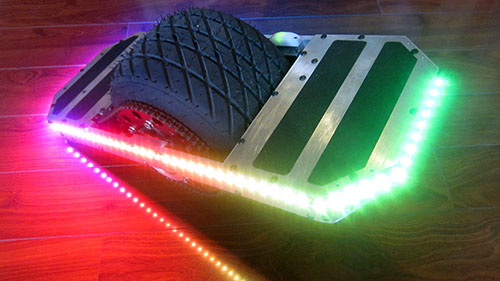
It's always exciting to build something that is grossly overpowered, then realize you have to actually get on it and ride it for the first time. I considered having a few beers with foolish younger friends, then casually suggesting that they have the honor of the first ride. My lack of patience got the better of me. I nervously gripped the back of a couch, and tilted the board up to a flat position. The balancing algorithm kicked in as expected, and I was able to ride (albiet wobbling the whole time) around the basement.
Much like the first skateboard, the initial ride was successful, and it seemed like I had things dialed in pretty well. I could use the infrared remote to adjust the agressiveness of the balancing algorithm while I was riding it. This allowed me to quickly find settings that felt "right". I then dumped those settings to a laptop that was connected via BlueTooth. I eventually would recompile the code to use those "good" settings as the default values.
This was already a huge step above the original skateboard, saving me from disassembling the frame, pulling out the microcontroller, uploading new code, putting everything back together, then repeating the process until I got it right.
The LED lights really add some visual flair to the skateboard. I'm still working out the best way to show interesting data via the light strip. Even though the board is mechanically solid, I suspect I'll iterate through the lighting displays for a long time to come.
The original skateboard had a bug in the software early on that caused it to think it was inverted if you were traveling at a high speed. This would cause it to cut power, throwing the rider into a panicked sprint. While I avoided that pitfall this time around, a similar issue plagued the intial configuration of the board. I had limited the max speed to 30% of total throttle. The problem was that it was easier to get to this speed than I expected, at which point any further leaning forward would simply cause the nose to drop. After experiencing this a few times, I cranked the max speed up to 70%, and haven't seen the issue since. I did add a warning flash to the LEDs once a rider gets to 95% of max throttle. That way you'll at least be warned that you're about to eat it.
The physical characteristics of this board were greatly improved over the previous version. Gone were the cases of digging in a corner during a sharp turn. It didn't take most people long to run into the physical cornering limitations of the first board. For this version, people get scared of speed and angles well before the board bottoms out. It's much better at handling hills too.
However, this version is more difficult to launch, since the starting angle is so much steeper. It took the better part of a day before I felt comfortable launching the board without holding on to a support of some kind. This is definitely a board for the "advanced" rider, the original board is much easier to learn on.
After riding it a bit, I jotted down some notes on what went well and what didn't.
